What is Gondwana?

Gondwana was an ancient supercontinent that broke up about 180 million years ago. The continent eventually split into landmasses we recognize today: Africa, South America, Australia, Antarctica, the Indian subcontinent and the Arabian Peninsula.
The familiar continents of today are really only a temporary arrangement in a long history of continental movement. Landmasses on Earth are in a constant state of slow motion, and have, at multiple times, come together as one. These all-in-one supercontinents include Columbia (also known as Nuna), Rodinia, Pannotia and Pangaea (or Pangea).
Gondwana was half of the Pangaea supercontinent, along with a northern supercontinent known as Laurasia.
The creation of Gondwana
Gondwana's final formation occurred about 600 million years ago, during the late Ediacaran period. By this time, multicellular organisms had evolved, but they were primitive: The few fossils left from this period reveal segmented worms, frond-like organisms and round creatures shaped like modern jellyfish.
In this world, Gondwana conducted its slow grind to supercontinent status. Bits and pieces of the future supercontinent collided over millennia, bringing together what are now Africa, India, Madagascar, Australia and Antarctica.
This early version of Gondwana joined with the other landmasses on Earth to form the single supercontinent Pangaea by about 300 million years ago. About 280 million to 230 million years ago, Pangaea started to split. Magma from below the Earth's crust began pushing upward, creating a fissure between what would become Africa, South America and North America.
As part of this process, Pangaea cracked into a northernmost and southernmost supercontinent. The northern landmass, Laurasia, would drift north and gradually split into Europe, Asia and North America.
The southern landmass, still carrying all those bits and pieces of the future southern hemisphere, headed southward after the split. This supercontinent was Gondwana.
Gondwana's breakup
During Gondwana's stint as the southerly supercontinent, the planet was much warmer than it was today — there was no Antarctic ice sheet, and dinosaurs still roamed the Earth. By this time, it was the Jurassic Period, and much of Gondwana was covered with lush rainforest.
The great supercontinent was still under strain, however. Between about 170 million and 180 million years ago, Gondwana began its own split, with Africa and South America breaking apart from the other half of Gondwana. About 140 million years ago, South America and Africa split, opening up the South Atlantic Ocean between them. Meanwhile, on the eastern half of the once-supercontinent, Madagascar made a break from India and both moved away from Australia and Antarctica.
Australia and Antarctica clung together longer; in fact, Antarctica and Australia didn't make their final split until about 45 million years ago. At that point, Antarctica started to freeze over as Earth's climate cooled, while Australia drifted northward. (Today, the Australian continent still moves north at a rate of about 1.2 inches (3 centimeters) a year.)
Gondwana theory
The exact mechanisms behind Gondwana's split are still unknown. Some theorists believe that "hot spots," where magma is very close to the surface, bubbled up and rifted the supercontinent apart. In 2008, however, University of London researchers suggested that Gondwana instead split into two tectonic plates, which then broke apart.
The existence of Gondwana was first hypothesized in the mid-1800s by Eduard Suess, a Viennese geologist who dubbed the theoretical continent "Gondwanaland." Suess was tipped off by similar fern fossils found in South America, India and Africa (the same fossils would later be found in Antarctica). At the time, plate tectonics weren't understood, so Suess didn't realize that all of these continents had once been in different locations. Instead, he developed a theory of sea level rise and regression over time that would have linked together the southern hemisphere continents with land bridges.
Suess got the name Gondwanaland from the Gondwana region of central India, where geological formations match those of similar ages in the southern hemisphere.
Follow Stephanie Pappas on Twitter and Google+. Follow us @livescience, Facebook & Google+. Original article on LiveScience.com.
Sign up for the Live Science daily newsletter now
Get the world’s most fascinating discoveries delivered straight to your inbox.

Stephanie Pappas is a contributing writer for Live Science, covering topics ranging from geoscience to archaeology to the human brain and behavior. She was previously a senior writer for Live Science but is now a freelancer based in Denver, Colorado, and regularly contributes to Scientific American and The Monitor, the monthly magazine of the American Psychological Association. Stephanie received a bachelor's degree in psychology from the University of South Carolina and a graduate certificate in science communication from the University of California, Santa Cruz.